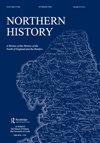DAVID CROUCH (ed.), The Metham Family Cartulary: Reconstructed from Antiquarian Transcripts
IF 0.2
3区 历史学
Q2 HISTORY
引用次数: 0
Abstract
The Methams of Yorkshire were a leading gentry family in the medieval period, whose origins can be traced back to the married clergy of Howden Minster in the twelfth century. When Thomas Metham commissioned the creation of the cartulary in c.1405, the family’s estates spanned across the East Riding and Vale of York. As this edition reveals, the Methams were involved in many of the pivotal events of the late medieval period, such as the civil wars between English kings and Simon de Montfort (d.1265) and Thomas, earl of Lancaster (d. 1322), and the Anglo-Scottish wars. In 2014, David Crouch described the late medieval cartulary that disappeared after 1680 as the ‘greatest loss’ to the Methams’ family archive because it contained an estimated 1,200 deeds over 250 folios. His latest offering, a scholarly edition of this cartulary based on antiquarian transcripts, reconstructs the text of some 700 of these deeds. The work also offers a detailed introduction that is split into nine parts, which discusses the text’s history, the sources for the edition, the disappearance of the original manuscript, the antiquarians’ relationships with the manuscript and their copies, and Crouch’s approach to reconstructing the ‘Metham Archive’. The edition itself provides material from the opening flyleaves, the main text of the cartulary, and the endpapers. There are also a further three appendices: the full text of the calendared deeds, a family history to 1416, and a discussion of the widowhood of Sybil Metham (n ee Hambleton), who was abducted after the death of John Metham for her claim to the considerable portfolio of properties created by her marriage to John. Therefore, the volume is packed with material that will undoubtedly be of great value to many future scholars. What first strikes the reader when perusing this volume is the enormous amount of work that Crouch has put into this edition. The text of the cartulary has been constructed from eight manuscript sources held by five different libraries and archives. In most cases the editor has given preference to James Torre’s English version of the text and Dr Nathaniel Johnston’s Latin abstracts (if they proved more detailed than Torre’s version), preserved in the Bodleian’s MS Top. Yorks b 14 and MS Top. gen. c56 respectively. These transcripts evidently brought diverse challenges to this project, as Crouch notes that Torre only had a limited knowledge of Latin and medieval dating clauses. Meanwhile, he describes Johnston’s handwriting as ‘abominable’ and in need of a ‘minor Rosetta Stone’ to help ‘decode’ the mysteries of his transcript (p. xl). Crouch even provides photographic evidence of this, should the reader doubt his assertions (p. xlii). In other places, where Torre and Johnston’s works are less revealing, the editor interweaves deeds and other information from the other manuscripts to form the most comprehensive reconstruction of the cartulary as possible. I particularly liked how deletions to the text have been shown using strikethrough text to大卫·克劳奇(编辑),《甲烷家族宪章:从古代抄本重建》
约克郡的Methams家族是中世纪的一个主要士绅家族,其起源可以追溯到12世纪豪登明斯特的已婚神职人员。大约1405年,托马斯·梅瑟姆委托创建了这座马车,当时这家人的庄园横跨东莱德和约克谷。正如本版所揭示的那样,Methams家族参与了中世纪晚期的许多关键事件,如英国国王与西蒙·德·蒙福特(公元1265年)和兰开斯特伯爵托马斯(公元1322年)之间的内战,以及盎格鲁-苏格兰战争。2014年,大卫·克劳奇(David Crouch)将1680年后消失的中世纪晚期手书描述为Methams家族档案的“最大损失”,因为它包含了大约1200份超过250对开本的契约。他最新出版的这本基于古物抄本的学术版漫画,重建了其中700多篇事迹的文本。这部作品还提供了一个分为九个部分的详细介绍,其中讨论了文本的历史、版本的来源、原始手稿的消失、考古学家与手稿及其副本的关系,以及克劳奇重建“甲烷档案馆”的方法。该版本本身提供了从扉页、图册正文和尾页的材料。此外还有三个附录:日历契约的全文、1416年的家族史,以及关于Sybil Metham(n ee Hambleton)守寡的讨论,她在John Metham去世后被绑架,因为她声称拥有与John结婚所创造的大量财产。因此,这本书所包含的材料无疑对许多未来的学者具有重要价值。当读者仔细阅读这本书时,首先映入眼帘的是克劳奇在这本书中所做的大量工作。该图册的文本由五个不同的图书馆和档案馆持有的八个手稿来源构成。在大多数情况下,编辑优先选择詹姆斯·托雷的英文版文本和纳撒尼尔·约翰斯顿博士的拉丁摘要(如果它们被证明比托雷的版本更详细的话),这些摘要保存在博德利的MS Top中。约克b 14和MS上衣。分别为c56代。这些文字记录显然给这个项目带来了各种各样的挑战,因为克劳奇指出,托雷对拉丁语和中世纪断代条款的了解有限。与此同时,他形容约翰斯顿的笔迹“令人憎恶”,需要一块“小罗塞塔石碑”来帮助“破解”他的成绩单的奥秘(第xl页)。克劳奇甚至提供了这方面的照片证据,如果读者怀疑他的断言(第xlii页)。在其他地方,托雷和约翰斯顿的作品不太具有启发性,编辑将其他手稿中的事迹和其他信息交织在一起,形成对漫画最全面的重建。我特别喜欢使用删除线文本来显示对文本的删除
本文章由计算机程序翻译,如有差异,请以英文原文为准。
求助全文
约1分钟内获得全文
求助全文
来源期刊

Northern History
Multiple-
CiteScore
0.20
自引率
33.30%
发文量
37
期刊介绍:
Northern History was the first regional historical journal. Produced since 1966 under the auspices of the School of History, University of Leeds, its purpose is to publish scholarly work on the history of the seven historic Northern counties of England: Cheshire, Cumberland, Durham, Lancashire, Northumberland, Westmorland and Yorkshire. Since it was launched it has always been a refereed journal, attracting articles on Northern subjects from historians in many parts of the world.
 求助内容:
求助内容: 应助结果提醒方式:
应助结果提醒方式:


